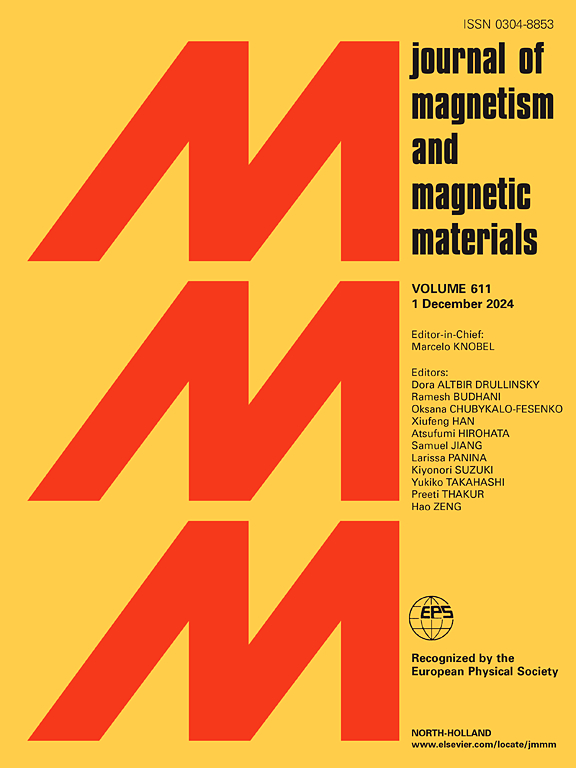CeFe2相对高性能Nd-Ce-Fe-B扩散磁体矫顽力的影响机理分析
IF 2.5
3区 材料科学
Q3 MATERIALS SCIENCE, MULTIDISCIPLINARY
引用次数: 0
摘要
在本研究中,我们制备了高性能(Nd, Ce)-Fe-B磁体,Ce /总稀土(TRE)含量分别为16.95 wt%和23.73 wt%,以及Dy扩散磁体。阐明了CeFe2相、微观结构和磁体矫顽力之间的关系。当Ce / TRE含量增加到23.73 wt%时,磁体中出现少量CeFe2相,提高了液相的流动性,促进了晶界相(GBs)的形成,优化了磁体的微观结构。因此,当GBs厚度增加到6.39 nm时,矫顽力略有增加。然而,在随后的重稀土晶界扩散过程中,有CeFe2相的磁体矫顽力增量(ΔHcj)为2.96 kOe,低于无CeFe2相磁体的4.68 kOe。从理论计算和实验结果来看,Dy元素的扩散通道被CeFe2相阻断,Dy原子将进入CeFe2相形成(Ce, Dy)Fe2相。因此,CeFe2相的存在导致Dy元素的扩散深度较小,主相的核壳结构较少,Dy的有效利用率较低,ΔHcj较低。本文章由计算机程序翻译,如有差异,请以英文原文为准。
Analysis of the influence mechanism of CeFe2 phase on coercivity in high-performance Nd-Ce-Fe-B diffusion magnets
In this study, we have prepared high-performance (Nd, Ce)-Fe-B magnets with 16.95 wt% and 23.73 wt% Ce / total rare earth (TRE) content, as well as Dy diffusion magnets. The concern between the CeFe2 phase, microstructure, and coercivity of the magnets was clarified. When the Ce / TRE content increased to 23.73 wt%, a little of the CeFe2 phase appeared in the magnet, which improved the fluidity of the liquid phase, promoted the formation of grain boundary phases (GBs), and optimized the microstructure. Therefore, when the GBs thickness increased to 6.39 nm, the coercivity slightly increased. However, in the subsequent heavy rare earth grain boundary diffusion, the coercivity increment (ΔHcj) of the magnet with the CeFe2 phase was 2.96 kOe, lower than the 4.68 kOe in the magnet without the CeFe2 phase. From theoretical calculations and experimental results, the diffusion channel of the Dy elements was blocked by the CeFe2 phase, and the Dy atom would enter the CeFe2 phase to form the (Ce, Dy)Fe2 phase. Therefore, the presence of the CeFe2 phase led to a smaller diffusion depth of Dy elements, less core–shell structure of the main phase, lower effective Dy utilization rate, and lower ΔHcj.
求助全文
通过发布文献求助,成功后即可免费获取论文全文。
去求助
来源期刊

Journal of Magnetism and Magnetic Materials
物理-材料科学:综合
CiteScore
5.30
自引率
11.10%
发文量
1149
审稿时长
59 days
期刊介绍:
The Journal of Magnetism and Magnetic Materials provides an important forum for the disclosure and discussion of original contributions covering the whole spectrum of topics, from basic magnetism to the technology and applications of magnetic materials. The journal encourages greater interaction between the basic and applied sub-disciplines of magnetism with comprehensive review articles, in addition to full-length contributions. In addition, other categories of contributions are welcome, including Critical Focused issues, Current Perspectives and Outreach to the General Public.
Main Categories:
Full-length articles:
Technically original research documents that report results of value to the communities that comprise the journal audience. The link between chemical, structural and microstructural properties on the one hand and magnetic properties on the other hand are encouraged.
In addition to general topics covering all areas of magnetism and magnetic materials, the full-length articles also include three sub-sections, focusing on Nanomagnetism, Spintronics and Applications.
The sub-section on Nanomagnetism contains articles on magnetic nanoparticles, nanowires, thin films, 2D materials and other nanoscale magnetic materials and their applications.
The sub-section on Spintronics contains articles on magnetoresistance, magnetoimpedance, magneto-optical phenomena, Micro-Electro-Mechanical Systems (MEMS), and other topics related to spin current control and magneto-transport phenomena. The sub-section on Applications display papers that focus on applications of magnetic materials. The applications need to show a connection to magnetism.
Review articles:
Review articles organize, clarify, and summarize existing major works in the areas covered by the Journal and provide comprehensive citations to the full spectrum of relevant literature.
 求助内容:
求助内容: 应助结果提醒方式:
应助结果提醒方式:


